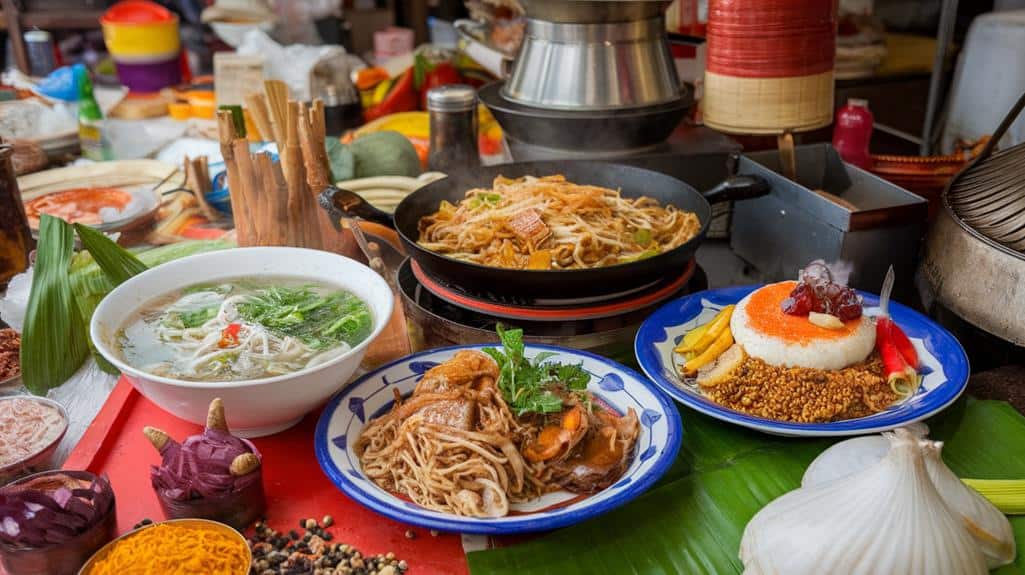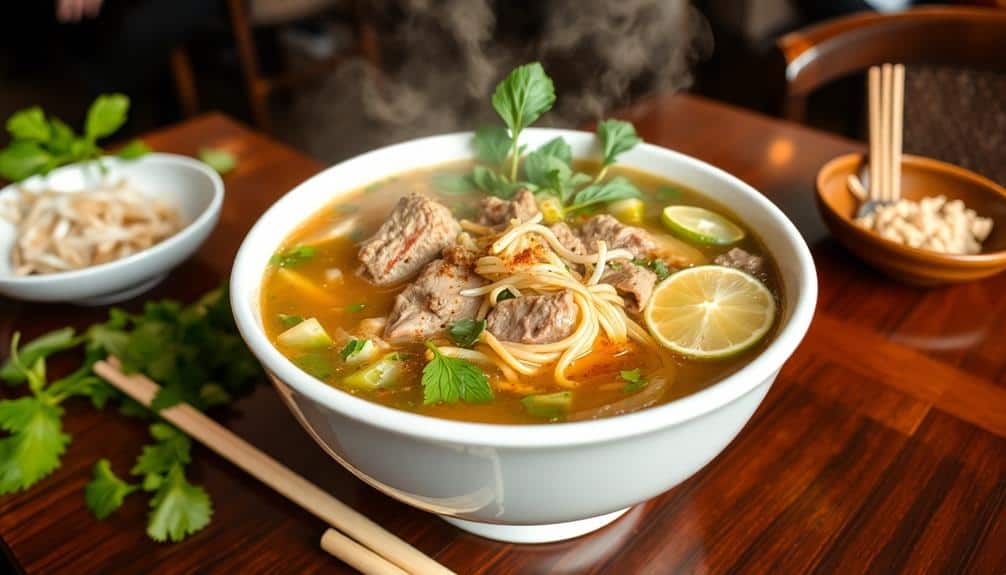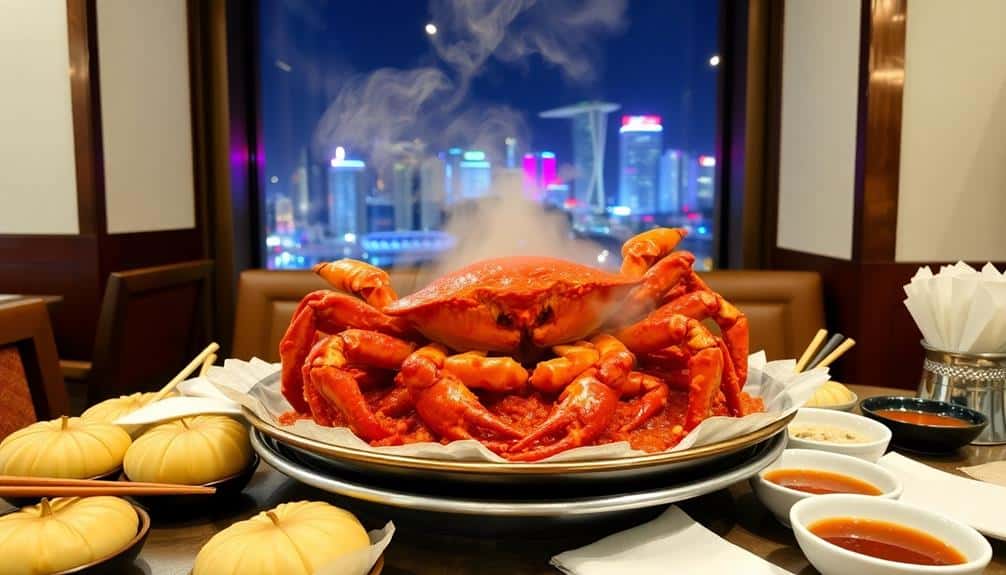
Top 3 Southeast Asian Culinary Delights for Travelers
Southeast Asia's culinary scene offers three must-try dishes for travelers. Thailand's Pad Thai combines flat rice noodles with a savory-sweet tamarind sauce, featuring tofu, dried shrimp, and crushed peanuts, all cooked in a wok for a distinctive smoky flavor. Vietnam's national dish, Pho, consists of an aromatic broth simmered for hours with tender meat and rice noodles, garnished with fresh herbs and bean sprouts. Singapore's Chili Crab showcases succulent mud crabs stir-fried in a spicy tomato-chili sauce, often served with fried mantou buns. Each dish represents its country's unique culinary heritage and offers a gateway to exploring the region's diverse flavors.
In a Nutshell
- Pad Thai, Vietnamese Pho, and Singaporean Chili Crab are iconic dishes representing Southeast Asian cuisine.
- These dishes offer unique flavors, textures, and cultural experiences for travelers exploring the region.
- Each dish showcases local ingredients and traditional cooking techniques specific to its country of origin.
- Travelers can find these delicacies in street-side stalls, local markets, and authentic restaurants throughout Southeast Asia.
- Sampling these dishes provides insight into the culinary heritage and food culture of Thailand, Vietnam, and Singapore.
Pad Thai From Thailand

At the top of any Southeast Asian food lover's list, Pad Thai reigns supreme as Thailand's most iconic dish. You'll find this stir-fried rice noodle masterpiece on street corners and in upscale restaurants throughout the country. The dish combines thin, flat rice noodles with a savory-sweet tamarind sauce, creating a perfect balance of flavors. Key ingredients include tofu, dried shrimp, bean sprouts, and crushed peanuts, often complemented by chicken or shrimp. For travelers who enjoy brewing their own coffee, compact coffee makers can be a great way to start the day before exploring local cuisines.
When ordering Pad Thai, you'll typically have the option to adjust spice levels to your preference. For an authentic experience, look for vendors using traditional woks over high heat, which imparts a distinctive smoky flavor known as "wok hei." To fully appreciate this culinary icon, pair it with a cold Thai iced tea, balancing the dish's complex flavors with a sweet, creamy beverage.
Vietnamese Pho

Often regarded as Vietnam's national dish, pho is a flavorful soup that's captivated food enthusiasts worldwide. This hearty meal consists of a aromatic broth, rice noodles, herbs, and tender meat, typically beef or chicken. You'll find pho served in countless street-side stalls and restaurants throughout Vietnam, each with its own unique twist on the classic recipe. The broth, simmered for hours with bones, spices, and aromatics, forms the foundation of this dish. When traveling, it's crucial to wear comfortable walking shoes to explore the various pho vendors and fully immerse yourself in the local culinary scene. When you order pho, it's customary to garnish it with fresh bean sprouts, Thai basil, lime wedges, and chili peppers to suit your taste. Don't forget to try both the southern and northern variations; southern pho tends to be sweeter and more herb-heavy, while northern pho is often simpler and saltier.
Singaporean Chili Crab

Among Singapore's most iconic dishes, chili crab stands out as a must-try delicacy for seafood lovers. This savory-sweet dish features succulent mud crabs stir-fried in a thick, spicy tomato-chili sauce. You'll find it served in restaurants across the city-state, often accompanied by mantou (fried buns) for soaking up the flavorful gravy. For travelers who enjoy portable coffee makers to complement their culinary adventures, Singapore offers an array of local coffee shops to explore as well.
To fully appreciate this culinary masterpiece:
- Use your hands to crack the shell and extract the tender meat
- Don't shy away from the messy experience; bibs are usually provided
- Pair it with a cold Tiger beer for a truly Singaporean dining experience
The dish's origins trace back to the 1950s when Cher Yam Tian first created it at her pushcart stall. Today, chili crab has become a national symbol of Singapore's diverse culinary heritage, combining Chinese, Malay, and Indian influences.
Frequently Asked Questions
What Are Some Vegetarian Options for Southeast Asian Cuisine?
Imagine a kaleidoscope of vibrant flavors dancing on your taste buds. You'll find Southeast Asian cuisine offers a wealth of vegetarian options. Tofu and tempeh, rich in protein, feature prominently in dishes like Indonesian gado-gado or Malaysian curry laksa. You can savor aromatic Thai green curry with vegetables, or indulge in Vietnamese fresh spring rolls filled with herbs and rice noodles. Don't miss Burmese tea leaf salad or Singaporean vegetable popiah, offering unique textures and tastes.
How Spicy Are Typical Southeast Asian Dishes?
When it comes to Southeast Asian cuisine, you'll encounter a wide range of spice levels. Many dishes are known for their fiery heat, often incorporating chili peppers, curry pastes, and spicy sauces. However, the spiciness can vary greatly depending on the specific dish, region, and personal preferences. You'll find that some dishes are mild, while others can be extremely hot. It's always a good idea to ask about the spice level when ordering and adjust accordingly to your taste.
Are There Any Common Allergens in Southeast Asian Food?
As you navigate the culinary landscape of Southeast Asia, be aware that common allergens lurk in the shadows of many dishes. Peanuts, tree nuts, and shellfish are prevalent, often hidden in sauces or used as garnishes. Soy, fish sauce, and shrimp paste are ubiquitous ingredients that may trigger allergies. Wheat, while less common, appears in some noodles and soy sauce. It's essential to communicate your allergies clearly when dining out, as cross-contamination can occur in bustling kitchens.
What's the Best Way to Eat Street Food Safely?
To eat street food safely, you'll want to prioritize hygiene and food handling practices. Choose vendors with high turnover and clean workstations. Opt for freshly cooked, hot foods prepared in front of you. Avoid raw or undercooked meats, and be cautious with unpeeled fruits or vegetables. Bring hand sanitizer and use it frequently. Consider carrying your own utensils. If possible, observe local eating habits and follow suit. Remember, while street food can be delicious, it's crucial to balance culinary adventure with caution.
How Do Portion Sizes in Southeast Asia Compare to Western Countries?
You'll generally find that portion sizes in Southeast Asia are smaller than those in Western countries. This difference is particularly noticeable in restaurants, where dishes are often meant for sharing. Street food portions tend to be more modest, allowing you to sample a variety of items without overindulging. It's common to order multiple dishes for a meal, creating a diverse and satisfying dining experience. You'll likely find yourself eating more frequently throughout the day, rather than consuming larger meals at set times.
